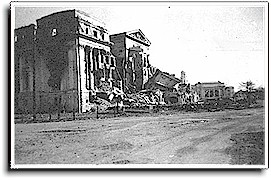|
|

The last phase of the Battle of Manila, excluding mopping-up operations, which, according to official communiqués, had been taking place since February 5, was conducted by the 148th Infantry from February 25 to March 2. After the seizure of Intramuros on February 23-24, the remaining Japanese held out in the Legislative, the Finance and the Agricultural Buildings. These three structures were among the finest public works in the Commonwealth's capital. They stood detached from all other constructions in an open park, displaying their monumental, four-story facades from every side across the lawns. The Legislative Building was just south of the intersection of P(adre) Burgos (street) and Taft Avenue. To the north, the golf links, the old Spanish moat having been filled, stretched the short distance to the walls of Intramuros. The Finance Building was a few yards to the south of that with the symmetrically designed Agricultural Building farther south, both along the east side of Gral Luna. These were not left until last by accident. The Japanese were conducting a true battle for the city and Rear Admiral Iwabuchi, the overall commander in Manila was cornered in the Agricultural Building during the fighting. There he made his last stand, husbanding his surviving troops about him until he was finally killed.
The reduction of these buildings was effected by the combination of many elements of XIV Corps: the 1st Cavalry Brigade, 637th Tank Destroyer Battalion, 82nd Chemical Battalion and the 37th Infantry Division. Along with the artillery, tanks, tank destroyers and M7s, the 4.2 mortars added their bit to the fire on March 2. Before the assault, the big mortars dropped in white phosphorous shells.